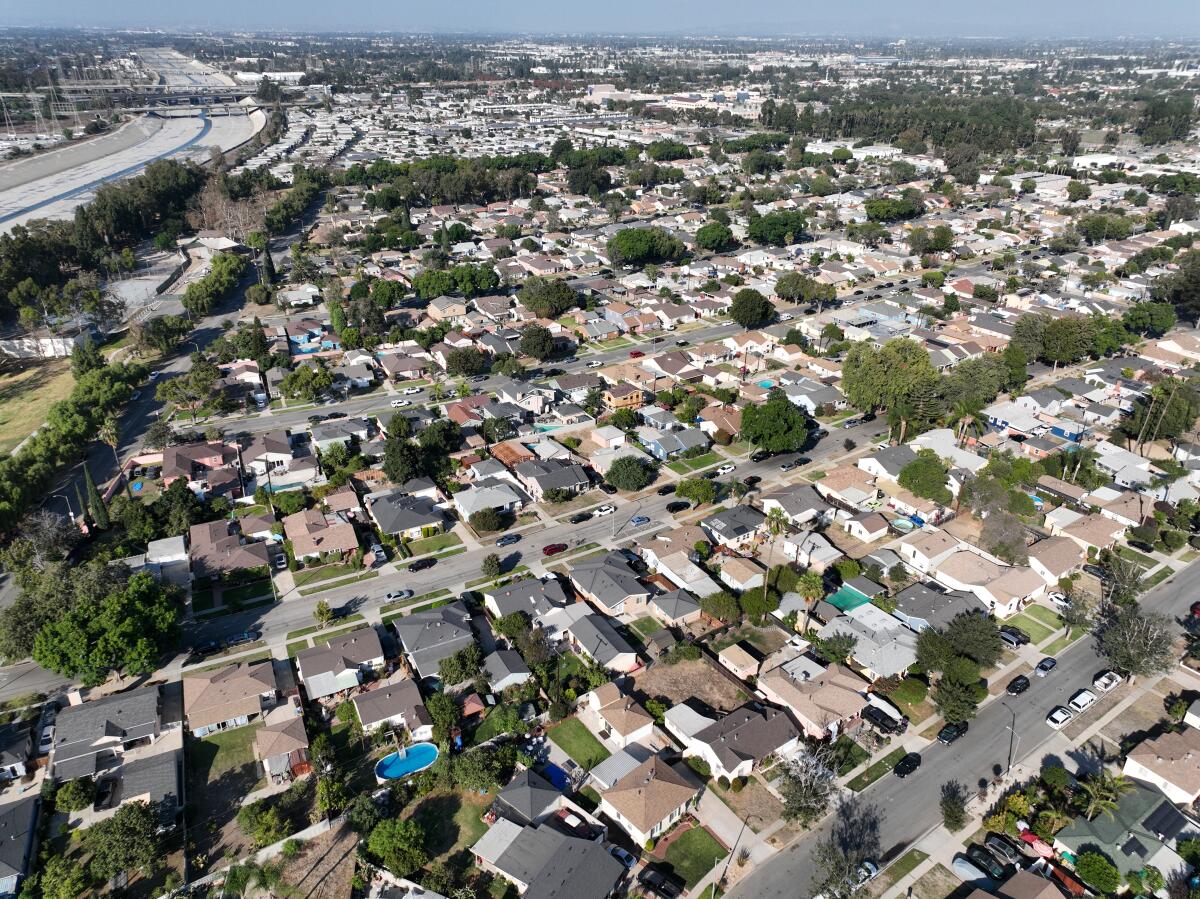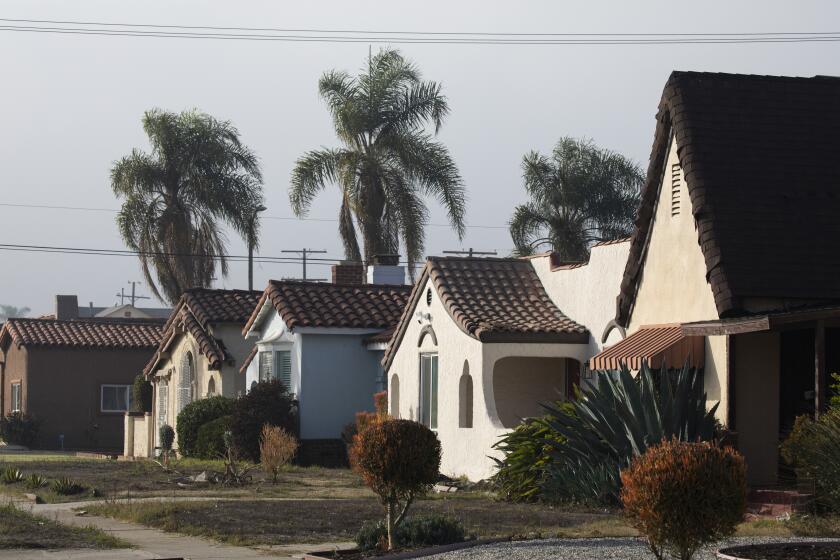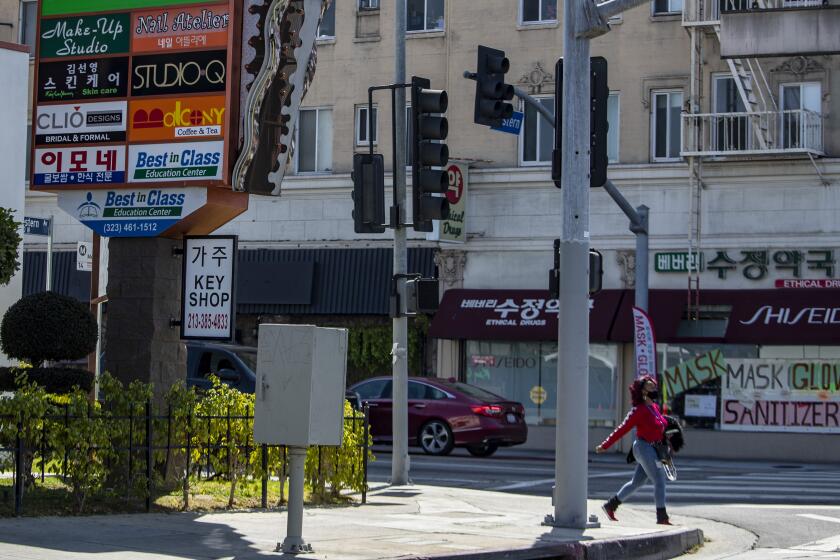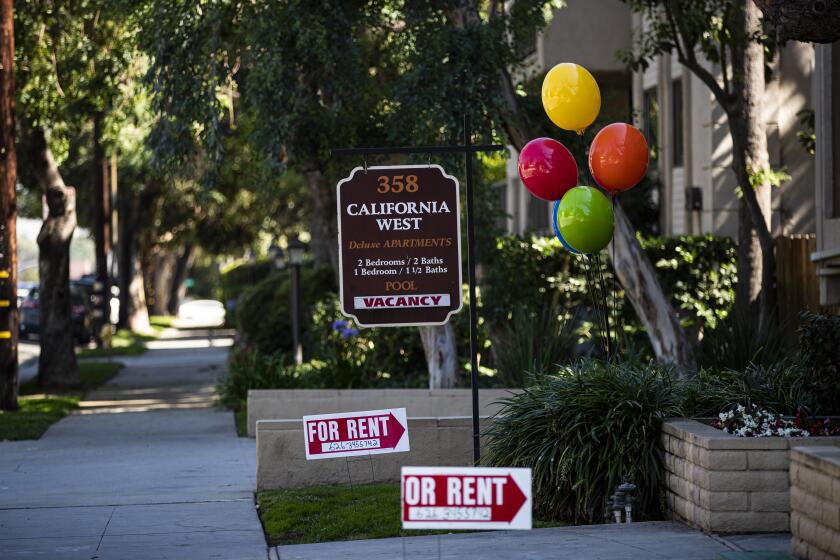Opinion: How L.A. can build more housing without looking like New York

- Share via
With the typical cost of a home in Los Angeles soon topping $1 million, and the state’s median rent approaching $3,000, there’s a sense of doom around how unaffordable California has become. We clearly need more housing density to meet the current needs. But we don’t have to sacrifice the lifestyle to which Californians have grown accustomed.
Los Angeles is geographically vast — nearly twice the size of Chicago and significantly larger than New York City, with much lower population density than those two cities. Jobs are nearly as dispersed here as homes, and none of our transportation options work that well: We are too sparse for trains and we have under-prioritized bus service, which most Angelenos don’t use because it’s rarely the fastest option. L.A. is built around cars, yet it’s also now too dense for vehicle traffic to move efficiently.
But this kind of sprawl can be put to good use. In contrast to Chicago and New York, whose commercial centers dwarf job prospects elsewhere in each city, Greater Los Angeles has numerous clusters of job-rich areas. The Westside and Irvine rival downtown L.A., and employment centers in Glendale, the West Valley, Long Beach, Anaheim and the Inland Empire each contains roughly half as many jobs as there are downtown.
Opinion: The $1-million home is becoming the norm in L.A. This is an outrage we could have prevented
California’s median home price is near $750,000. The most promising prescription for the housing shortage is undoing single-family zoning and increasing density.
We can reframe our planning for housing around these medium-density urban hubs, which are scattered throughout the region. This approach has been a successful and flexible model, especially outside the U.S. Consider the densely populated suburbs of Tokyo, which offer varied housing types and transportation options, or the suburbs of many major European cities built around lower density townhomes, row houses or smaller apartment buildings and duplexes. Often those developments are close to a commuter rail station that can take residents into the central city in less than 45 minutes.
Maximizing our multiple job centers requires that we shift course from our single-family-dominated residential landscape to hit a sweet spot that works for Californians: more density, but not so dense that Angelenos will have to sacrifice the space we’re used to. We should focus on increasing smaller multifamily housing (i.e. two to eight units) while still making it possible for people to live close enough to employment centers.
To do this, we have to reform our land use — including laws that discourage building for density — to provide alternatives to sprawling single-family neighborhoods. This does not necessarily mean obliterating the urban forms and communities that have been built in the past century. But without some densification, we’ll keep pushing people and development into the Inland Empire and other outlying areas (which is already happening). The result is predictable: more punishing commutes and, in all likelihood, still expensive housing.
We were first-generation Latina home buyers seeking to get our family out of a crowded 450-foot apartment. Here’s how our housing search went.
I live in a single-family home on L.A.’s Westside, and I see firsthand how laws that favor my type of home hold the neighborhood back. Although I live next door to multifamily housing, those apartments and townhomes are the exception in my neighborhood. Restrictions on building anything but a single-family home or an accessory dwelling unit stretch a mile from my house to the nearest stop on the Metro E (formerly known as Expo) Line. Restrictions on building apartments apply to most land plots in a one-mile radius around that Metro stop.
These zoning limitations make no sense: They mean too few people can live close enough to generate the ridership necessary to justify the immense investment it took to build the E Line. Further, the neighborhood’s single-family housing is so astronomically expensive — a million dollars will get you … nothing — that the people most likely to rely on the E Line cannot afford to live there. There are several reasons why ridership is down on L.A. Metro’s trains and buses, and too little density near transit is a major reason.
Remote work has also opened up new possibilities for housing in Southern California. A key factor that continues to drive up real estate in central cities is the increased tendency for higher-income households to live closer to highly urbanized areas. Remote work can help ease these rent pressures by making some central neighborhoods less appealing for higher-income office workers who no longer have to go into a downtown office.
Neighborhoods such as Echo Park and Boyle Heights might see some relief from constantly rising rents and displacement pressures. More strategic planning around transit-rich neighborhoods would further relax rent increases in these neighborhoods. If we can allow for greater density in more neighborhoods, particularly in zones close to dispersed job centers such as Santa Monica, Pasadena and Burbank, then the areas most at risk of gentrification should see some relief.
We want to hear how you navigated the costly housing market in L.A. Tell us your story.
This approach would also allow greater flexibility in the type of development needed to meet state housing mandates. Under state guidelines, Southern California has to add 1.3 million housing units by 2029. If we have, by a conservative estimate, at least 12 major job centers, each hub should be zoned to serve 100,000 units of housing within commuting distance to reach the 2029 goal.
With remote work and less than daily commutes, the potential commuting distance many workers are willing to accept will be greater. In turn, this significantly expands the land area where we can build units to serve an employment hub, providing workers with many more potential housing possibilities. But only if we allow them to be built.
Los Angeles has a unique urban landscape. Because of our many dispersed employment-rich centers and broad geography, we don’t have to mimic East Coast cities to increase housing density. We don’t need to build condo towers or skyscraper apartment buildings to house everyone. The path to a more livable and equitable future is clear: Allow more housing in a diversity of well-connected neighborhoods, and L.A. can still remain L.A.
Michael Lens is a professor of urban planning and public policy, and associate faculty director of the Lewis Center for Regional Policy Studies at UCLA.
More to Read
A cure for the common opinion
Get thought-provoking perspectives with our weekly newsletter.
You may occasionally receive promotional content from the Los Angeles Times.













